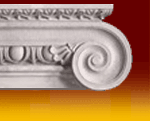|
Pop Art (an abbreviation of 'popular art') was a movement in the visual arts in the 1950's and 1960's most prominent in the
United States and Great Britain. Pop Art was largely influenced by Dadaist pieces and often Pop Artists had previously worked
as commercial artists, and the images used in their works were taken from mass culture. Objects such as road signs, comic
strips, beer bottles and soup cans were used in sculptures and their images were duplicated in photographs and paintings.
Modern industrial materials like plastics, glass, acrylic paint and urethane foam were often used in artworks. Pop Artists
had a large influence over subsequent commercial, graphic and fashion design.
Pop Art began as an objection to Abstract Expressionism, which the Pop Artists considered to be too intellectual, as well
as subjective and unrealistic. They therefore began to use materials from their everyday environment to produce their artworks,
minimising the gap between life an art. Rather than representing their environments through imagery, the Pop Artists conveyed
a true perception of reality by portraying images that reflected traits of modern society such as materialism, consumerism,
and similar vulgarities. They also attempted to keep subjectivity and opinion from their pieces, so that a viewer would be
able to respond to them without being influenced to opinion or reaction.
The first artists in America whose works inspired the development of Pop Art were Robert Rauschenberg and Jasper Johns:
Rauschenberg used household items like quilts and pillows to create collages, whereas Johns painted a series of paintings
of American flags and bull's-eyes. In 1956 a British artist named Richard Hamilton created the first genuine Pop artwork,
"Just What Is It That Makes Today's Home So Different, So Appealing"?
Pop Art flourished during the 1960's, beginning with David Hockney producing Typhoo Tea, one of the first paintings to
include a brand-name product. Other Pop Artists to emerge during this decade were Claes Oldenburg (who created humorous sculptures
of hamburgers and miscellaneous fast food), Roy Lichtenstein (whose oil paintings resembled enlarged comic strip frames) and
Andy Warhol (who disputed the notion that only the artist can give their work meaning).

Warhol conveyed (amongst other things) the mass production and commercialism of the 60's by producing hundreds of identical
silk-screen prints of Coca-Cola bottles, Campbell's soup cans and other familiar commercial items.
Back
|

